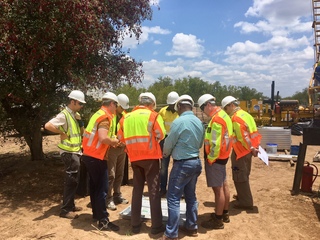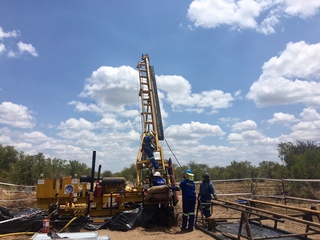MOD has been in Botswana since 2011, discovering the T1 deposit (aka Mahumo), which has a small, but high-grade resource of 2.5Mt containing 2% copper and 50 grams per tonne silver, the same year.
But it was the late 2015 acquisition of 6300sq.km of adjacent and nearby ground in the central and western part of the Kalahari Copper Belt that proved to be a game-changer.
The ground was picked up from the liquidators of Discovery Metals, but Hanna explained on a site visit to Botswana last week that the company initially only a small part of the ground.
The liquidators had an all-or-nothing approach, which led to the company and 30% partner, AIM-listed Metal Tiger, taking the lot.
It wasn't the first time Hanna had been in that position - early last decade while at Western Areas the company did a deal to acquire a large package of Forrestania nickel tenements.
At the time, the company had only wanted a portion of the ground but had to take all of it.
The Flying Fox nickel discovery was made on a tenement Western Areas initially didn't plan to acquire and the rest, as they say, is history.
Hanna said the parallels were "spooky" given the T3 deposit was made on a piece of ground initially not sought by MOD.
Terry Grammar, who was previously at Western Areas, is a director of Metal Tiger.
T3 was discovered only months after the acquisition, in March 2016, with the initial holes returning visible chalcopyrite and high tenor bornite sulphides in the first round of drilling.
The first round of assays included 4m grading 1.97% copper from 86m down hole, including 7m at 2.9% copper.
Within six months of discovery, T3 had a maiden resource of 28.36 million tonnes at 1.24% copper and 15.7gpt silver for around 350,000 tonnes of copper and 14.27 million ounces of silver, using a 0.5% cut-off.
Two weeks ago, MOD released a prefeasibility study into a 2.5Mt per annum operation at T3 to produce an average 23,000 tonnes per annum of copper and 690,000 ounces per annum of silver at C1 costs of US$1.22 per pound of copper and all-in sustaining costs of $1.36/lb, including silver credits.
Pre-production capital costs would be $155 million, including $17 million contingency, while life-of-mine sustaining capex would be just $31 million.
Using a copper price of $3/lb, the study returned a pre-tax net present value of $281 million, at an 8% discount rate.
The initial 8.8-year mine life is based on a maiden reserve of 218,000t of copper and 7.1Moz of silver.
The project is estimated to generate earnings before interest, tax, depreciation and amortisation of around $730 million and net cashflow of $530 million over its life.
The payback period would be just 2.7 years from the start of production, which is slated for mid-2020.

An expansion case assumes a rise in throughput to 4Mtpa from year four for an 11.7-year mine life to produce an average 28,000tpa of copper and 903,000ozpa of silver at AISC of $1.46/lb.
The plant upgrade is expected to cost just $37 million, while the NPV would jump to $402 million.
Under the expansion case, LOM EBITDA could be as high as $1.1 billion with net cashflow of $840 million and a payback period of 3.3 years.
The expansion case is based partially on inferred resources and a drilling program is currently underway to upgrade the confidence before the end of June as part of a full feasibility study, which is already underway.
This year is shaping up to be extraordinarily busy for MOD on a number of fronts.
Aside from the T3 open pit, the partners will also calculate a resource for the T3 underground and kick off a scoping study.
The partners are completing a scoping study into an underground mine at T3.
"We're hoping for the big kahuna under T3," Hanna said.
Hanna said the target is a 1Mtpa operation over 10 years to produce 15,000tpa.

That would take production to 38,000tpa and adding a third production centre would give MOD some serious scale.
"T1 comes on and suddenly we're a mid-cap producer," Hanna said.
Drilling is set to start at T1 this week ahead of an underground scoping study to begin in June.
The company is also set to drill T-Rex, T3 Dome, T20 Dome, T4 and T7 Domes in the current half.
The focus for the past two years has been T3, but Hanna noted that the company has 22 prospects with little to no drilling along the belt.
MOD has eight drill rigs in action currently.

























